

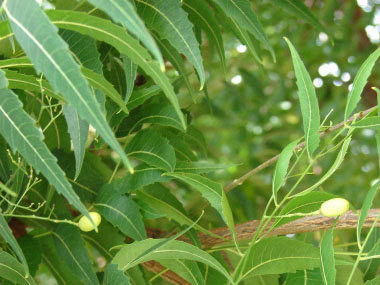
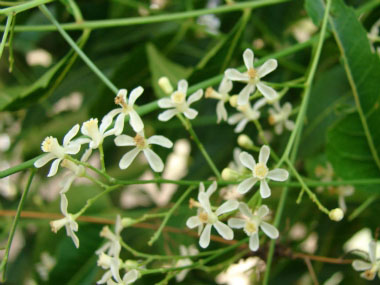
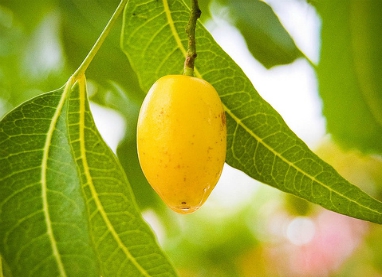
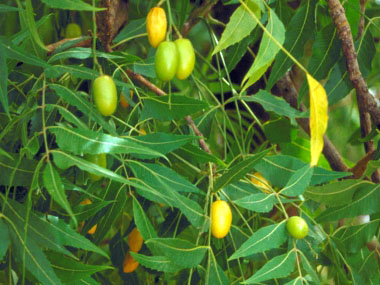
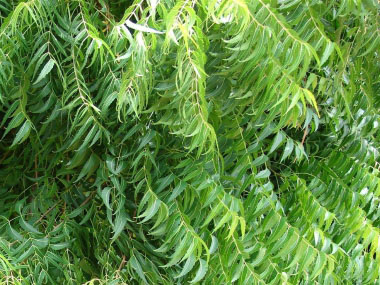
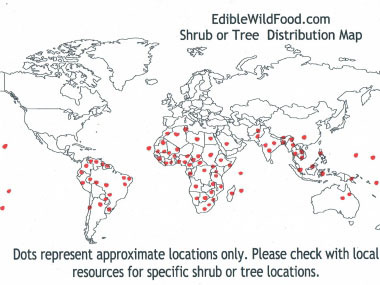
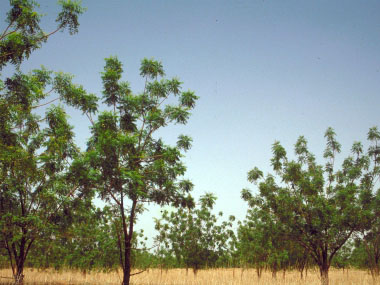
To support our efforts please browse our store (books with medicinal info, etc.).
The Neem tree, Azadirachta indica, is in the Meliaceae (mahogany) family. Also know as Nimtree and Indian Lilac, neem is a large deep-rooted tree that is fast growing with many uses including medicinal properties. This tree is native to the Indian subcontinent (India, Nepal, Pakistan, Bangladesh, and Sri Lanka). It is categorically an evergreen, but in severe drought it may shed most or nearly all of its leaves. Neem is referred to as being a weed tree in many areas, including some parts of the Middle East, northern Australia and much of sub-Saharan Africa. Large infestations have also been observed in West African nations. The name Azadirachta comes from: Azad means free; Dirakht means tree; and i-Hind means of Indian origin.
Trunk/Bark
The trunk is straight. Neem bark is hard, rough and scaly, and fissured even in young trees. It's often brown, but older trees can be pale or greyish-black.
Branches/Twigs
This tree's spreading branches form rounded crowns as much as 20 metres across. It makes an excellent shade tree.
Height
Neem can reach a height of 15 to 20 metres, though it occasionally reaches 35 to 40 metres.
Leaves/Needles
The opposite, simple pinnate leaves are 20 to 40 cm long, with 20 to 30 medium to dark green leaflets about 3 to 8 cm long. The leaf petioles are short. Young leaves are reddish to purplish in colour. Leaf margins are toothed.
Flowers
Neem flowers are white and fragrant that arise from the junction of the stem and petiole. They are normally in drooping flower clusters (panicles) which are up to 25 cm long. These branching inflorescences, bear from 150 to 250 flowers. An individual flower measures 5 to 6 mm long and 8 to 11 mm wide.
Fruit
The fruit is a smooth olive-like drupe which varies in shape from elongate oval to nearly roundish. When ripe they measure anywhere from 1.5 to 3 cm by 1 to 1.5 cm. The fruit skin is thin and turns yellow when ripe. The bitter-sweet pulp is yellowish-white and very fibrous. The white, hard inner shell of the fruit encloses one, rarely two or three, elongated seeds.
Habitat
Neem likes open woodlands, grasslands, floodplains, riparian zones, coastal sites and other disturbed natural vegetation. It can grow in semi-shade or full sun. It prefers dry or moist soil and can tolerate drought. It cannot survive freezing temperatures or being waterlogged. Neem has naturalized in northern Australia, Southeast Asia, parts of Africa, Fiji, Mauritius, Puerto Rico, the Caribbean and many countries in South and Central America.
Edible Parts
Edible parts include the fruit, leaves, flowers, and sap. Young leaves are cooked and eaten in parts of Asia. According to PFAF, leaves can be eaten raw or fried along with other vegetables. Flowers are used as a flavouring. Fully ripe fruit pulp is eaten raw or cooked and used for drinks. Refined oil from the seeds can be used for cooking.
Other Name
Margosa Tree.
Recipes
Winter Survival Food Handbook

PDF Plant Magazines
Types of Wild Food
Geographic Zones Seasons
Disclaimer
EdibleWildFood.com is informational in nature. While we strive to be 100% accurate, it is solely up to the reader to ensure proper plant identification. Some wild plants are poisonous or can have serious adverse health effects.
We are not health professionals, medical doctors, nor are we nutritionists. It is up to the reader to verify nutritional information and health benefits with qualified professionals for all edible plants listed in this web site. Please click here for more information.
Why Edible Wild Food?
- Food costs are rising
- Free, wild food is readily abundant
- Wild food adds nutrition to your diet
- Wild food can help treat various medical conditions





